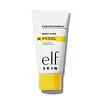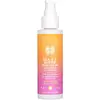What's inside
What's inside
 Key Ingredients
Key Ingredients

 Benefits
Benefits

 Concerns
Concerns

 Ingredients Side-by-side
Ingredients Side-by-side

Butyl Methoxydibenzoylmethane 3%
UV AbsorberHomosalate 9%
Skin ConditioningEthylhexyl Salicylate 5%
UV AbsorberOctocrylene 7%
UV AbsorberWater
Skin ConditioningGlycerin
HumectantPolyglyceryl-3 Distearate
EmulsifyingCI 77163
Cosmetic ColorantNiacinamide
SmoothingAluminum Starch Octenylsuccinate
AbsorbentTrehalose
HumectantSilica
AbrasivePanthenol
Skin ConditioningSodium Hyaluronate
HumectantSqualane
EmollientAloe Barbadensis Leaf Juice
Skin ConditioningGlyceryl Stearate Citrate
EmollientCetearyl Olivate
Sorbitan Olivate
EmulsifyingStearyl Caprylate
EmollientStearic Acid
CleansingPalmitic Acid
EmollientDimethicone
EmollientCetearyl Alcohol
EmollientStearyl Heptanoate
EmollientPolyacrylate-13
Polyisobutene
Polysorbate 20
EmulsifyingEthylhexyl Hydroxystearate
EmollientSorbitan Isostearate
EmulsifyingTriethoxycaprylylsilane
Acrylates/Polytrimethylsiloxymethacrylate Copolymer
Skin ConditioningCaprylyl Glycol
EmollientEthylhexylglycerin
Skin ConditioningPotassium Sorbate
PreservativePhenoxyethanol
PreservativeDisodium EDTA
Sodium Benzoate
MaskingCitric Acid
BufferingIron Oxides
Butyl Methoxydibenzoylmethane 3%, Homosalate 9%, Ethylhexyl Salicylate 5%, Octocrylene 7%, Water, Glycerin, Polyglyceryl-3 Distearate, CI 77163, Niacinamide, Aluminum Starch Octenylsuccinate, Trehalose, Silica, Panthenol, Sodium Hyaluronate, Squalane, Aloe Barbadensis Leaf Juice, Glyceryl Stearate Citrate, Cetearyl Olivate, Sorbitan Olivate, Stearyl Caprylate, Stearic Acid, Palmitic Acid, Dimethicone, Cetearyl Alcohol, Stearyl Heptanoate, Polyacrylate-13, Polyisobutene, Polysorbate 20, Ethylhexyl Hydroxystearate, Sorbitan Isostearate, Triethoxycaprylylsilane, Acrylates/Polytrimethylsiloxymethacrylate Copolymer, Caprylyl Glycol, Ethylhexylglycerin, Potassium Sorbate, Phenoxyethanol, Disodium EDTA, Sodium Benzoate, Citric Acid, Iron Oxides
Octocrylene 2.9%
UV AbsorberWater
Skin ConditioningButyloctyl Salicylate
Skin ConditioningCoconut Alkanes
EmollientCalcium Sodium Borosilicate
Cetearyl Alcohol
EmollientParfum
MaskingPropanediol
SolventAscorbic Acid
AntioxidantTocopherol
AntioxidantAscophyllum Nodosum Extract
Skin ConditioningAlgae Extract
EmollientWithania Somnifera Root Extract
Skin ConditioningAloe Barbadensis Leaf Juice
Skin ConditioningCaffeine
Skin ConditioningCaprylhydroxamic Acid
Caprylyl Glycol
EmollientCellulose Gum
Emulsion StabilisingCoco-Caprylate/Caprate
EmollientCoco-Glucoside
CleansingEthyl Ferulate
AntioxidantFructose
HumectantGlycerin
HumectantGlyceryl Stearate
EmollientLauroyl Lysine
Skin ConditioningMicrocrystalline Cellulose
AbsorbentSodium Gluconate
Skin ConditioningSodium Stearoyl Glutamate
CleansingXanthan Gum
EmulsifyingOctocrylene 2.9%, Water, Butyloctyl Salicylate, Coconut Alkanes, Calcium Sodium Borosilicate, Cetearyl Alcohol, Parfum, Propanediol, Ascorbic Acid, Tocopherol, Ascophyllum Nodosum Extract, Algae Extract, Withania Somnifera Root Extract, Aloe Barbadensis Leaf Juice, Caffeine, Caprylhydroxamic Acid, Caprylyl Glycol, Cellulose Gum, Coco-Caprylate/Caprate, Coco-Glucoside, Ethyl Ferulate, Fructose, Glycerin, Glyceryl Stearate, Lauroyl Lysine, Microcrystalline Cellulose, Sodium Gluconate, Sodium Stearoyl Glutamate, Xanthan Gum
 Reviews
Reviews

Ingredients Explained
These ingredients are found in both products.
Ingredients higher up in an ingredient list are typically present in a larger amount.
Aloe Barbadensis Leaf Juice comes from leaves of the aloe plant. Aloe Barbadensis Leaf Juice is best known for helping to soothe sunburns. It is also anti-inflammatory, moisturizing, antiseptic, and can help heal wounds.
Aloe is packed with good stuff including Vitamins A, C, and E. These vitamins are antioxidants, which help fight free-radicals and the damage they may cause. Free-radicals are molecules that may damage your skin cells, such as pollution.
Aloe Barbadensis Leaf Juice also contains sugars. These sugars come in the form of monosaccharides and polysaccharides, folic acid, and choline. These sugars are able to help bind moisture to skin.
It also contains minerals such as calcium, 12 anthraquinones, fatty acids, amino acids, and Vitamin B12.
Learn more about Aloe Barbadensis Leaf JuiceCaprylyl Glycol is a humectant and emollient, meaning it attracts and preserves moisture.
It is a common ingredient in many products, especially those designed to hydrate skin. The primary benefits are retaining moisture, skin softening, and promoting a healthy skin barrier.
Though Caprylyl Glycol is an alcohol derived from fatty acids, it is not the kind that can dry out skin.
This ingredient is also used as a preservative to extend the life of products. It has slight antimicrobial properties.
Learn more about Caprylyl GlycolCetearyl alcohol is a mixture of two fatty alcohols: cetyl alcohol and stearyl alcohol. It is mainly used as an emulsifier. Emulsifiers help prevent the separation of oils and products. Due to its composition, it can also be used to thicken a product or help create foam.
Cetearyl alcohol is an emollient. Emollients help soothe and hydrate the skin by trapping moisture.
Studies show Cetearyl alcohol is non-toxic and non-irritating. The FDA allows products labeled "alcohol-free" to have fatty alcohols.
This ingredient is usually derived from plant oils such as palm, vegetable, or coconut oils. There is debate on whether this ingredient will cause acne.
Due to the fatty acid base, this ingredient may not be Malassezia folliculitis safe.
Learn more about Cetearyl AlcoholGlycerin is already naturally found in your skin. It helps moisturize and protect your skin.
A study from 2016 found glycerin to be more effective as a humectant than AHAs and hyaluronic acid.
As a humectant, it helps the skin stay hydrated by pulling moisture to your skin. The low molecular weight of glycerin allows it to pull moisture into the deeper layers of your skin.
Hydrated skin improves your skin barrier; Your skin barrier helps protect against irritants and bacteria.
Glycerin has also been found to have antimicrobial and antiviral properties. Due to these properties, glycerin is often used in wound and burn treatments.
In cosmetics, glycerin is usually derived from plants such as soybean or palm. However, it can also be sourced from animals, such as tallow or animal fat.
This ingredient is organic, colorless, odorless, and non-toxic.
Glycerin is the name for this ingredient in American English. British English uses Glycerol/Glycerine.
Learn more about GlycerinOctocrylene protects skin from sun damage. It absorbs UV-B with peak absorption of 304 nm. It is a common sunscreen ingredient and often paired with avobenzone, a UVA filter. This is because octocrylene stabilizes other sunscreen ingredients by protecting them from degradation when exposed to sunlight. Octocrylene is a photostable ingredient and loses about 10% of SPF in 95 minutes.
Octocrylene also acts as an emollient, meaning it helps skin retain moisture and softens skin. It is oil-soluble and hydrophobic, enhancing water-resistant properties in a product.
Those who are using ketoprofen, a topical anti-inflammatory drug, may experience an allergic reaction when using octocrylene. It is best to speak with a healthcare professional about using sunscreens with octocrylene.
The EU allows a maximum of these concentrations:
Learn more about OctocryleneWater. It's the most common cosmetic ingredient of all. You'll usually see it at the top of ingredient lists, meaning that it makes up the largest part of the product.
So why is it so popular? Water most often acts as a solvent - this means that it helps dissolve other ingredients into the formulation.
You'll also recognize water as that liquid we all need to stay alive. If you see this, drink a glass of water. Stay hydrated!
Learn more about Water